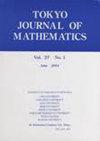Reconstruction of the Defect by the Enclosure Method for Inverse Problems of the Magnetic Schrödinger Operator
IF 0.3
4区 数学
Q4 MATHEMATICS
引用次数: 1
Abstract
This study is based on the paper [1]. We give the formula to extract the position and the shape of the defect D generated in the object (conductor) Ω from the observation data on the boundary ∂Ω for the magnetic Schrödinger operator by using the enclosure method proposed by Ikehata [2]. We show a reconstruction formula of the convex hull of the defect D from the observed data, assuming certain higher regularity for the potentials of the magnetic Schrödinger operator, under the Dirichlet condition or the Robin condition on the boundary ∂D in the two and three dimensional case. Let Ω ⊂ R(n = 2, 3) be a bounded domain where the boundary ∂Ω is C and let D be an open set satisfying D ⊂ Ω and Ω \ D is connected. The defect D consists of the union of disjoint bounded domains {Dj}j=1, where the boundary of D is Lipschitz continuous. First, we define the DN map for the magnetic Schrödinger equation with no defect D in Ω. Here, let D Au := ∑n j=1 DA,j(DA,ju), where DA,j := 1 i ∂j +Aj and A = (A1, A2, · · · , An). Definition 1. Suppose q ∈ L∞(Ω), q ≥ 0, A ∈ C(Ω, R). For a given f ∈ H(∂Ω), we say u ∈ H(Ω) is a weak solution to the following boundary value problem for the magnetic Schrödinger equation { D Au+ qu = 0 in Ω, u = f on ∂Ω, (1.1)磁性Schrödinger算子逆问题的包体法缺陷重构
本研究基于论文[1]。利用Ikehata[2]提出的封闭方法,我们给出了从磁薛定谔算子边界上的观测数据中提取物体(导体)Ω中产生的缺陷D的位置和形状的公式。我们从观测数据中给出了缺陷D的凸包的重建公式,假设磁薛定谔算子的势在二维和三维情况下,在边界上的Dirichlet条件或Robin条件下具有更高的正则性。设Ω⊂R(n=2,3)是一个边界为C的有界域,设D是一个满足D⊁Ω的开集,Ω\D是连通的。缺陷D由不相交的有界域的并集组成{Dj}j=1,其中D的边界是Lipschitz连续的。首先,我们定义了Ω中没有缺陷D的磁薛定谔方程的DN映射。这里,设D Au:=∑n j=1 DA,j(DA,ju),其中DA,j:=1 iõj+Aj和A=(A1,A2,··,An)。定义1。设q∈L∞(Ω),q≥0,A∈C(Ω,R)。对于给定的f∈H(⏴Ω),我们认为u∈H是磁薛定谔方程{D Au+qu=0 inΩ,u=f on⏴Ω,(1.1)的边值问题的弱解
本文章由计算机程序翻译,如有差异,请以英文原文为准。
求助全文
约1分钟内获得全文
求助全文
来源期刊

Tokyo Journal of Mathematics
MATHEMATICS-
CiteScore
0.70
自引率
16.70%
发文量
27
审稿时长
>12 weeks
期刊介绍:
The Tokyo Journal of Mathematics was founded in 1978 with the financial support of six institutions in the Tokyo area: Gakushuin University, Keio University, Sophia University, Tokyo Metropolitan University, Tsuda College, and Waseda University. In 2000 Chuo University and Meiji University, in 2005 Tokai University, and in 2013 Tokyo University of Science, joined as supporting institutions.
 求助内容:
求助内容: 应助结果提醒方式:
应助结果提醒方式:


